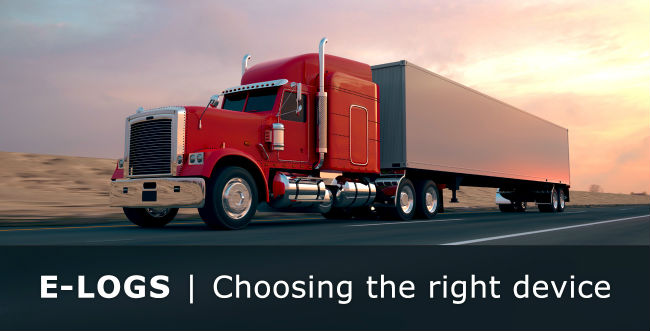ELD Rollout Checklist: Tips for a Successful Implementation
Download a free checklist and get tips for a successful ELD rollout, including updating your Hours of Service policy and procedures.


With the ELD Mandate deadline around the corner, it is critical that companies review and strengthen their Hours of Service (HOS) compliance program to support the move from paper logs to electronic logging devices (ELDs) or from AOBRD to ELD. To help fleets with their ELD rollout, Geotab has outlined the key steps in this article and provided a free downloadable checklist (below).
Key steps of an ELD implementation:
- Review and update company Hours of Service policies and procedures.
- Conduct ELD training for management, drivers, and affected staff.
- Carry out regular auditing and provide ongoing support.
See also:
NMFTA raises the bar on ELD security standards
1. Review and update Hours of Service policies and procedures
The first step to implementation is to update your Hours of Service policy and procedures to include the use of ELDs. Clearly stating roles and responsibilities will help ensure that drivers and employees follow required procedures.
Examples of items you may want to include in your company’s policies and procedures:
- How management will monitor and track logs.
- How to prevent dispatchers from assigning a load to drivers without hours available to complete the load on time.
- A statement prohibiting drivers from driving in violation when they are out of hours under any circumstances.
- Disciplinary measures and corrective action for violations to ensure drivers comply with regulations and policies.
Assigning responsibilities
Creating a policy that assigns specific tasks and responsibilities to the appropriate personnel will help ensure that procedures are carried out as required.
ELD compliance is a team effort, so responsibilities should be assigned to personnel across the organization, not just drivers. It’s especially important to define and document the roles and responsibilities of managers and supervisors so they can monitor and to maintain fleet compliance with HOS policies.
Consider the following types of personnel when updating your policy:
- Executive Managers
- Health & Safety and/or Risk Management Personnel
- Administrators
- Supervisors
- Drivers
Remember that designing a robust policy is only the first part. In order to be effective, policies must be properly communicated and made available to personnel.
Share these tips with your team! Get the free fillable checklist.
2. Conduct ELD training
Training is imperative during the transition period to ELDs to ensure a successful implementation. Each company should convey expectations to all applicable staff for adhering to HOS regulations and company policies and procedures.
Schedule training far enough in advance of the ELD deadline so that drivers and managers have time to learn and become comfortable with the new system.

Depending on the size of your team, it might be more effective to carry out separate training sessions for managers, administrative personnel, supervisors and drivers, with information that is customized to their group. It’s natural that questions may arise, so build flexibility into the training sessions to allow time to address any concerns. That type of feedback can be very useful in refining policy and procedures or developing future training.
The following items should be considered as part of the training program:
- ELD regulations and benefits.
- How to operate an ELD and properly complete a log.
- How to track and edit the Hours of Service of drivers.
- How to schedule routes that can be completed within Hours of Service regulations.
- Common practices that may lead to violations.
- How to handle ELD data retention.
- Preventing driver harassment and coercion.
- Troubleshooting.
Initial training should be followed up with regular and ongoing training sessions to keep HOS policies and procedures top-of-mind and ensure your fleet maintains compliance.
3. Auditing and ongoing support
As drivers move from paper logs to ELDs, the way they think about their logs needs to change. Now is the time to increase the frequency of your internal audits to ensure your logs are being correctly completed and your process is working correctly. Your company should implement an effective process for monitoring, tracking, and evaluating driver compliance with HOS regulations and company policies.
It is the company’s responsibility to promptly review all Records of Duty Status for Hours of Service violations.
Areas of action for auditors:
- Review driver compliance with their ruleset.
- Review the Driver Vehicle Inspection Report (DVIR) logs.
- Ensure that drivers are verifying and signing off on their logs daily.
- Identify trips that were made with no drivers assigned, find the driver who made the trip, and assign that driver to the trip.
Reinforcing policy with driver coaching
How are you are going to handle violations or mistakes in the driver’s log? Policy and procedures should be established to address these issues. A good procedure can lead to great opportunities for coaching your drivers.
Some companies design and implement incentives and recognition programs in order to reward and encourage effective performance related to driver compliance with HOS regulations and company policy — for example, bonuses or gift certificates.
Driver Coaching Tips:
- Let the driver know specifically what his violation is and how it was discovered.
- Train the driver on how to comply with the violated regulation.
- Instruct drivers on the consequences of continual violations.
- Reinforce training about HOS policies, procedures, and responsibilities.
Investing in success
Setting aside time for careful planning and policy management is always a good investment. Creating a comprehensive set of policies and procedures for Hours of Service and ELDs will help your company make a smooth transition to electronic logging devices. By putting time and effort into building a strong compliance program, you are ultimately investing in the success of your drivers and maximizing the value you will get out of your ELD solution.
Learn more about fleet compliance management and ELDs from Geotab.
Related:
Is your company’s distracted driving policy up-to-date?
Duty of care for fleet managers
Turning driver safety into fleet success: Safelite AutoGlass interview
While Geotab recognizes our place as a self-registered ELD manufacturer and provider and we will answer questions regarding those Hours of Service (HOS) ruleset options we provide, neither Geotab nor any of its employees, officers or agents can offer legal advice to any resellers or customers concerning which HOS ruleset(s) or exemption(s) may apply to any particular situation. Please contact your local DOT department or refer to the FMCSA website at https://www.fmcsa.dot.gov/ for questions Geotab is unable to answer.
Subscribe to get industry tips and insights

Robin Kinsey has over 25 years of sales experience in a combination of individual contributor and sales management.
Table of Contents
Subscribe to get industry tips and insights
Related posts

Clean Truck Check: How to comply with California's standards [2025]
January 26, 2025
4 minute read

FIPS 140-3 validation: What it is and what it means for Geotab customers
December 18, 2024
2 minute read



